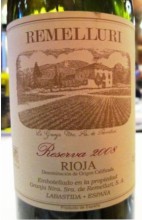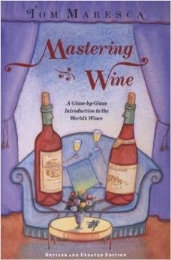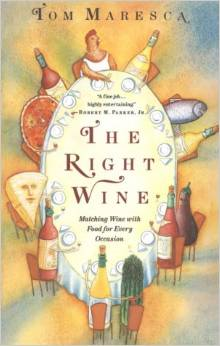I’m posting now about the inexpensive case of mixed, everyday red wines I put together as a complement to the dozen everyday white wines I talked about two posts back.
.
We drink a lot of white wine at Casa Maresca, but we consume even more red. I’d guess that two out every three, maybe three out of four, dinners we make call for red wines – and since I care strongly about making the wine and food play happily together, it means I like to keep a good variety of red wines on hand. And that means, of course, reasonably priced wines, for all the obvious reasons.
Enough prologue: Here’s the list.
- Barale Barbera d’Alba 2017 Castlé
- Barale Dolcetto d’Alba 2017 Le Rose
- Bodegas Olarra Rioja Reserva 2010 Cerro Anon
- Cà Lustra di Zanovelli Marzemino 2017 Belvedere
- Centopassi Nero d’Avola 2016 Argille di Tagghia Via
- Château de Plaisance Anjou Rouge 2017 Entre Copains
- Cuvée des Galets (Côtes du Rhône) 2016
- Filipa Pato (Vinho Tinto Bairrada DOC) Baga 2017
- Oreste Buzio Freisa del Monferrato 2017
- Oreste Buzio, Grignolino del Monferrato 2017 Casalese
- Villa Sant’Anna Chianti Colli Senese 2015
- Viña Real Rioja Crianza 2015
In selecting this batch of wines, I was not trying to be experimental, to try new wines or kinds of wines I’m not familiar with. Food compatibility was the goal, and compatibility with the kinds of food we cook every day was the guiding principle of selection. Hence the preponderance of Italian wines on the list, and especially the large presence of Piedmontese wines, which I think are particularly food-friendly, and which – happily – are available in good variety in the New York area.
 Barbera and Dolcetto I find are especially useful. Barbera’s medium body and high acidity make it compatible with an extraordinary range of foods, from – to choose a few random examples – asparagus frittata to tomato-based sauces to grilled sausages or even steaks, especially gamy cuts like skirt steak or hanger steak. Dolcetto is softer-bodied and far less acid, and it loves buttery sauces, mushrooms, more delicate meat – especially veal in any form.
Barbera and Dolcetto I find are especially useful. Barbera’s medium body and high acidity make it compatible with an extraordinary range of foods, from – to choose a few random examples – asparagus frittata to tomato-based sauces to grilled sausages or even steaks, especially gamy cuts like skirt steak or hanger steak. Dolcetto is softer-bodied and far less acid, and it loves buttery sauces, mushrooms, more delicate meat – especially veal in any form.
Nero d’Avola is also medium-bodied, and on the palate feels and tastes Merlot-ish. Its strong suits are stews and brown-sauced casseroles – really any dish that isn’t aggressively sauced or spiced.
 Even more useful – the utility infielder of red wines – is that perfectly named Anjou red, Entre Copains – “among pals,” which is how I envision large quantities of this wine must be drunk on its home turf. It’s 100% Cabernet franc, which is a Loire valley specialty, and this is one of most welcoming versions of it I’ve encountered. Its pleasing, soft, generic red fruit would match with anything from a good pizza on up the culinary scale to simple roasts and grilled meats. It’s practically the definition of an enjoyable everyday wine.
Even more useful – the utility infielder of red wines – is that perfectly named Anjou red, Entre Copains – “among pals,” which is how I envision large quantities of this wine must be drunk on its home turf. It’s 100% Cabernet franc, which is a Loire valley specialty, and this is one of most welcoming versions of it I’ve encountered. Its pleasing, soft, generic red fruit would match with anything from a good pizza on up the culinary scale to simple roasts and grilled meats. It’s practically the definition of an enjoyable everyday wine.
The Côtes du Rhône wasn’t quite that all-niches useful: By itself, it was a fairly light, high-acid Rhône, with cherryish fruit and a good finish, but it rounded nicely and gained some flesh with food, especially with cheese.
The Baga from Filipa Pato was also surprisingly soft on the palate and versatile with food. It stood up well, for instance, to mideastern spiced lamb meatballs and to Indian chutneys and pickles. Filipa is the daughter of Luis Pato, the acknowledged master of this grape in Portugal, and with this particular wine she has chosen a different path from that of her father’s formidable bottles.
 The Grignolino and Freisa are more specialized wines that I couldn’t resist buying, since I don’t encounter them that often. Both are light-bodied, light-fruited reds ideal for warm weather quaffing, which is exactly what I’m saving them for. I should have done that too with the Colli Senese Chianti: These are always at-most-medium-bodied and fruity, with a touch of Sangiovese elegance, but this bottle was a tad too light for matching with cold weather dinners.
The Grignolino and Freisa are more specialized wines that I couldn’t resist buying, since I don’t encounter them that often. Both are light-bodied, light-fruited reds ideal for warm weather quaffing, which is exactly what I’m saving them for. I should have done that too with the Colli Senese Chianti: These are always at-most-medium-bodied and fruity, with a touch of Sangiovese elegance, but this bottle was a tad too light for matching with cold weather dinners.
The Marzemino was another wine I selected simply because I don’t get many chances to taste it. This one turned out to be a big, not entirely balanced wine, black-plum fruited and a touch hot: It loved steak and mushrooms, but wasn’t too happy with anything else.
The two Riojas – Crianza and Reserva, at opposite ends of the aging spectrum – were both a bit disappointing. I love Rioja and find it very useful as a dinner wine, but of these two bottles the Reserva was too young of its kind and yet still too important for everyday utility, while the Crianza had been exposed to too much oak, which diminished its freshness and charm. I won’t give up on Rioja, however: I’ll just have to sample some others.
And there’s my necessary excuse to order some more wine. Diane, look away.






























